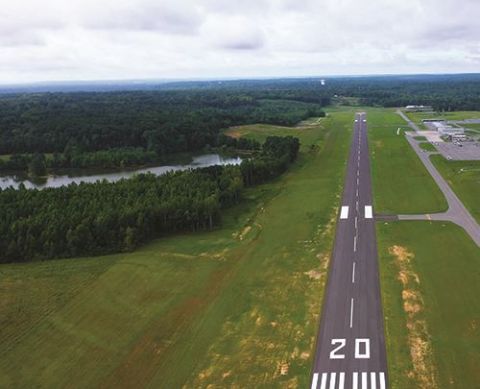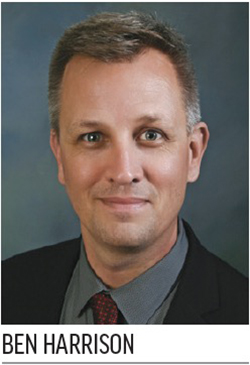Reconstructed Runway is Crowning Achievement in Cullman Regional’s Airfield Overhaul


When Ben Harrison became director at Cullman Regional Airport-Folsom Field (CMD) one decade ago, there were several projects that needed his attention. Originally constructed in 1958, the north/south runway had been improved throughout the years, but there were limited records about the work.
Earlier this year, the north Alabama airport unveiled a completely new airstrip with fresh markings and new LED lighting. Moreover, preliminary plans are in the works to extend it by 1,000 feet in the future.
“The runway probably had a couple overlays since it was built, but who knows how all that all came together,” muses Harrison.
|
Project: Runway Reconstruction/Extension Location: Cullman (AL) Regional Airport New Dimensions: 5,500 ft. long, 100 ft. wide Rehab Method: Full-depth reclamation Cost: $4.2 million Funding: $3.6 million from FAA; $277,000 from AL Dept. of Transportation; $149,000 from city; $149,000 from county Notice to Proceed: Sept. 2021 Construction Completed: Jan. 2022 Engineer: Goodwyn Mills Cawood LLC LED Lighting: ADB SAFEGATE Runway Grooving: Cardinal/Int’l Grooving & Grinding Concurrent Project: Automated Weather Observation System System: AWOS III-PT from All Weather Inc. Funding: $250,000 FAA grant |
During the past 60-plus years, different levels of base material and asphalt had been piecemealed together on the runway, and surrounding taxiway and connector pavement was in similar condition. Surface cracks with weeds sprouting out of them were raising safety concerns about foreign object debris.
Realizing the need for change, the airport board assembled a team of engineers from Goodwyn Mills Cawood LLC in 2014 to address the runway and other airfield pavement.
“We needed maintenance in several areas,” Harrison recalls, noting CMD’s excitement about strategizing with one of the largest architecture and engineering firms in the Southeast at the time. “We sat down with our engineering group to better understand what the problems were and how we were going to fix all of those problems.”
With input from the Alabama Department of Transportation and guidance from the FAA, the airport leveraged the expertise of Goodwyn Mills Cawood to develop a plan to overhaul the airfield in a highly prioritized manner.
Solutions on Approach
Natalie Hobbs, a senior aviation engineer at Goodwyn Mills Cawood, led the efforts at CMD.
“There were a lot of different priorities, but in 2014, we decided to go back and make sure that all of the infrastructure that they currently had was in good shape, because a lot of it was really aging and showing some fatigue signs that were going to make the project take longer,” Hobbs explains. “We knew if we put it off, it was going to be more expensive to rehabilitate.”
The engineering firm drew up an updated Airport Layout Plan that was quickly implemented. Phase after phase, and year after year, taxiways were rehabilitated, connectors were rebuilt, land was cleared, and a new concrete apron was constructed—all in lockstep with the prescriptive, prioritized design plan.
The rebuilt north/south runway, which was debuted in late January 2022, was the final piece of movement area pavement that needed to be addressed. Given its condition, the project team opted for a full-depth reclamation, which pulverizes and blends the existing pavement structure with cement to create a stabilized base for the new buildup.
 “We basically dug it up, mixed it up, and put it back down so that we didn’t have to haul off a lot of material,” explains Hobbs. “We didn’t have to bring in new base, and reused the material that was on site.”
“We basically dug it up, mixed it up, and put it back down so that we didn’t have to haul off a lot of material,” explains Hobbs. “We didn’t have to bring in new base, and reused the material that was on site.”
Harrison notes that pre-construction analysis drove the decision for full-depth reclamation. “The core samples really told the story and gave us a good roadmap of how we needed to move forward,” he explains.
“The runway was built in several phases, and there was quite a bit of pavement buildup in three different sections,” Hobbs adds. “So what we designed completely reconstructed the entire thing.”
She expects the upcycled runway base, new top pavement and associated improvements to serve the airport well for 20 years or more.
The $4.2 million project was primarily funded with a $3.6 million FAA grant. The nearly $600,000 contributed by the city, county and state paid for portions not eligible for FAA funding, such as maintaining the runway’s 100-foot width rather than reducing it to 75 feet. The city and county spent additional funds to clear the runway approach.
“We removed a lot of trees, and the approach has been improved,” Hobbs reports. “Everything is clear and clean and safe, and so much more usable for aircraft.”
With the last piece of its airfield overhaul complete, CMD is already beginning another airport layout plan. “Now that we have all the existing infrastructure stabilized, we are starting to look at projects for the next five, 10 and 20 years,” says Hobbs.
Future Development
Based on positive outcomes of the recent runway project and previous airfield improvements, Harrison anticipates continued success with upcoming efforts to improve CMD.
“One thing that has helped us is consistency,” Harrison reflects. “We have been consistent with our story, consistent with our plan, and also with our communication.”
As airport director he strives to make sure everyone is well aware of what the airport is attempting to accomplish. That includes the airport board, its engineering team and key contacts from the city, county, state and FAA.
“We keep everything out there, and we are very engaged,” Harrison emphasizes. “Because we talk about projects through the years, it really shouldn’t take a lot of information when it’s time to execute them, because everyone has heard it so many times moving forward.”

Looking 20, 30 and even 40 years down the road, some of the projects in CMD’s new airport layout plan may lie outside the fence.
“We will have some non-airside and some airside projects, and we want to break it down in a realistic timeline,” Harrison says. “We want to determine what our goals are going to be and how we start to achieve them.”
The airport’s new five-year plan includes several capital improvement program projects. Initiatives planned for next year include reconstructing the general aviation apron, rehabilitating the terminal apron and developing hangars on the south side of the airfield. Currently, CMD has 10 corporate hangars and 56 T hangars.
A new corporate hangar in 2023, perimeter fencing and more taxiway rehabilitation are tentatively on the docket for 2024, and drainage improvements and new hangar development in 2025. In 2026, the airport plans to complete an environmental assessment for extending the north end of its north/south runway, followed by associated land acquisition and construction in 2027.
Harrison fully expects to garner local support for the proposed projects that lie ahead. “Everything that we said we were going to do in the last seven years, we have completed,” he reasons. “We have proven to the local delegation that we have a well-thought-out plan. We do our best to evaluate the outcome of every decision. We have proven ourselves to the state, and we have proven ourselves to the FAA. We cannot thank the local, state, and federal leaders enough for their trust and support. Now, it is just building on that foundation.”
In short, Harrison describes CMD as an airport that is “always moving forward to meet the needs of our clients.”
FREE Whitepaper
PAVIX: Proven Winner for All Airport Concrete Infrastructure
International Chem-Crete Corporation (ICC) manufactures and sells PAVIX, a unique line of crystalline waterproofing products that penetrate into the surface of cured concrete to fill and seal pores and capillary voids, creating a long lasting protective zone within the concrete substrate.
Once concrete is treated, water is prevented from penetrating through this protective zone and causing associated damage, such as freeze-thaw cracking, reinforcing steel corrosion, chloride ion penetration, and ASR related cracking.
This white paper discusses how the PAVIX CCC100 technology works and its applications.
 facts&figures
facts&figures








